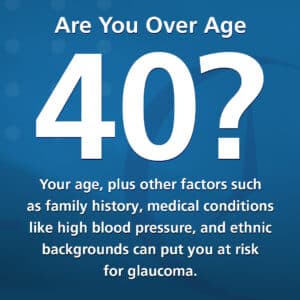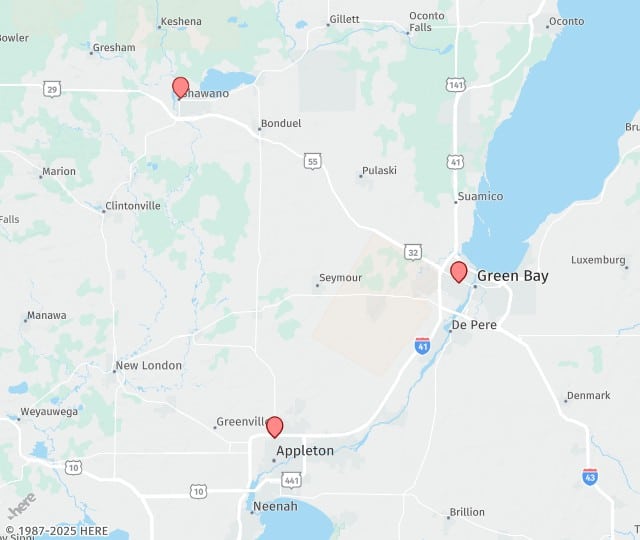Welcome to our glaucoma FAQ page at Tower Clock Eye Center. Glaucoma is a serious eye condition that can lead to vision loss if not properly managed, and we’re here to help you understand this condition better.
Whether you’re looking for information on risk factors, treatment options, or how to detect glaucoma early, you’ll find answers to many pressing questions below. We’re committed to providing you with the knowledge and care you need to protect your vision. For more information on cataract treatment or surgery, call (920) 499-3102 or schedule a consultation with one of our doctors.
What Is Glaucoma?
Glaucoma is a group of eye conditions that can damage the optic nerve, which is the part of your eye that sends visual information to your brain. The most common type is called open-angle glaucoma. This happens when the fluid in your eye (called aqueous humor) doesn’t drain properly, causing pressure to build up over time.
Usually this fluid drains through channels called the trabecular meshwork, located where the iris and cornea meet. But when those drainage channels get blocked or aren’t working properly, pressure increases, which can harm the optic nerve. The tricky part about glaucoma is that it often doesn’t show any symptoms early on, which is why it’s frequently called the “silent thief of sight.” That means you might not notice anything until significant damage has been done.
However, there’s another type called acute angle-closure glaucoma that’s a little different. It happens suddenly when the drainage angle between the iris and cornea becomes blocked, causing sharp eye pain and blurry vision. This type needs immediate medical attention.
What Causes Glaucoma?
The primary cause of glaucoma stems from problems within the eye’s complex drainage system. When fluid builds up instead of draining properly, it creates increased pressure inside the eye. This elevated pressure can gradually compress and damage the optic nerve, disrupting the transmission of visual information to the brain.
In some cases, glaucoma can develop even if eye pressure is normal, a condition known as normal-tension glaucoma. Other factors like reduced blood flow to the optic nerve, weakened nerve structure, or various medical conditions can contribute to optic nerve damage and vision loss.
Can You Prevent Glaucoma?

Since many people develop glaucoma without any obvious cause, it’s important to work with your optometrist or ophthalmologist to figure out the right screening schedule for you based on your individual health and risk factors. Early treatment can help prevent long-term damage.
Is Glaucoma Hereditary?
Having a familial history of glaucoma significantly increases your risk of developing the condition. When one family member has glaucoma, their close relatives should undergo more frequent eye exams since their chances of developing the disease are much higher than the general population.
However, genetics represent just one piece of the puzzle. Many people develop glaucoma without any genetic history of the disease. This complexity makes regular screening crucial, regardless of family background.
What Is Usually the First Sign of Glaucoma?
The first sign of glaucoma is often hard to notice, especially with open-angle glaucoma, the most common type. This form of glaucoma typically develops slowly without any immediate symptoms.
Over time, it can damage the optic nerve and affect peripheral vision. Because of its subtle progression, significant damage can occur before it’s detected, which is why regular eye exams are so crucial for early detection.
On the other hand, acute angle-closure glaucoma has sudden, severe symptoms that you can’t miss. These include intense eye pain, blurred vision, seeing halos around lights, and sometimes nausea. This type of glaucoma requires immediate medical attention to avoid rapid vision loss.
If you notice any changes in your vision, it’s important to talk to your optometrist or ophthalmologist right away.
What Is It Like To Have Glaucoma?

Managing glaucoma usually involves a daily treatment routine, often with eye drops to help control eye pressure. Regular check-ups with your ophthalmologist or optometrist are essential to track the condition’s progression and make any necessary adjustments to your treatment. While glaucoma requires ongoing care, most people with the condition are able to maintain good central vision if they follow their treatment plan.
Is There Only One Type of Glaucoma?
No, there are several distinct types of glaucoma, each with unique characteristics and treatment approaches. A comprehensive eye exam will determine which type of glaucoma you may have and can help identify the best options to treat glaucoma. Glaucoma symptoms can be subtle at first, so it’s crucial to schedule routine eye exams every year.
What Are the Different Types of Glaucoma?
Here are the most common types of glaucoma:
- Open-angle glaucoma: The most common type of glaucoma, open-angle glaucoma, occurs when pressure builds gradually due to poor fluid drainage. This condition is also called primary open-angle glaucoma in some cases.
- Acute-angle closure glaucoma: In contrast to open-angle glaucoma, acute-angle glaucoma involves a sudden blockage of the drainage angle between the iris and cornea, causing severe eye pain and requiring immediate medical attention as a medical emergency.
- Normal tension glaucoma: A unique type where optic nerve damage occurs despite having normal pressure levels.
- Secondary glaucoma: This develops as a result of other medical conditions, injuries or medications.
- Congenital glaucoma: A rare type that children are born with, congenital glaucoma is also referred to as childhood glaucoma.
- Narrow-angle glaucoma: Where the drainage angle between the iris and cornea is narrower than normal, increasing the risk of blockage.
- Neovascular glaucoma: Caused when abnormal vessels grow into the trabecular meshwork, blocking the drainage of fluid from the eye.
- Pigmentary glaucoma: Caused by pigment, rubbed free from the iris, forming deposits in the cornea and trabecular meshwork. It blocks drainage from the eye.
Do Different Types of Glaucoma Have Different Symptoms?

- Open-angle glaucoma: Even though this is the most common type of glaucoma, most people don’t have symptoms early in the disease. Symptoms may appear much later in the disease, and they include a slow loss of vision or tunnel vision.
- Angle-closure glaucoma: Also known as closed-angle glaucoma, this medical emergency involves symptoms including sudden and severe eye pain, decreased vision, cloudy vision, or halos around bright or dim lights.
- Congenital glaucoma: This is a rare condition, but parents may notice symptoms in their children, such as very large eyes, excessive tear production, cloudy corneas and noticeable sensitivity to light.
- Pigmentary glaucoma: Symptoms typically include seeing halos around lights and blurred vision with exercise.
Understanding the symptoms of different types of glaucoma can help you identify potential warning signs early so you can seek the right treatment and protect your vision.
How Is Glaucoma Treated?
Glaucoma treatment is all about lowering eye pressure to prevent further damage to the optic nerve. The most common treatment starts with prescription eye drops that either reduce fluid production or help it drain more efficiently. In some cases patients may need to use more than one type of eye drop to keep the pressure under control.
If eye drops aren’t enough, your doctor might recommend laser treatment or even surgery. There are minimally invasive procedures available, which are especially effective when combined with cataract surgery. For more advanced cases of glaucoma, traditional surgery might be needed to create new drainage channels and help prevent permanent vision loss.
Can You Drive With Glaucoma?
Many people with glaucoma continue driving, particularly in the early stages when their vision loss is minimal. However, the extent of peripheral vision loss plays a crucial role in determining driving ability. Regular visual field eye exams help monitor changes in peripheral vision that might affect driving safety.
As the condition progresses, some individuals may need to adjust their driving habits, such as avoiding driving at night or during challenging weather conditions. The key is working closely with an eye doctor to monitor vision changes and determine when driving modifications become necessary.
Can Glaucoma Be Cured?
Currently, there is no cure for glaucoma, but proper treatment can effectively slow or stop its progression. Once damage occurs to the optic nerve, it cannot be reversed, making early diagnosis and prompt treatment essential for preventing permanent vision loss. The focus of glaucoma treatment centers on preserving remaining vision through careful management of eye pressure.
Can Glaucoma Lead to Blindness?
While glaucoma can cause blindness, early diagnosis and proper treatment significantly reduce this risk. About 5% of people with glaucoma experience blindness, though more may experience various degrees of vision impairment. The progression typically begins with loss of peripheral vision and, if untreated, can eventually affect central vision.
At Tower Clock Eye Center, we’re here to guide you every step of the way and help you manage glaucoma with the best treatment options available so you can feel confident in preserving your vision. The key to preventing blindness lies in catching the disease in its early stages before significant nerve damage occurs.
How Does Eye Pressure Affect Glaucoma?
Eye pressure plays a central role in most forms of glaucoma, acting as both a key risk factor and a primary target for treatment. When intraocular pressure rises above normal levels, it can compress the delicate fibers of the eye’s optic nerve, leading to gradual damage and vision loss. Think of it like a balloon – too much pressure inside can stretch and damage the structure.
However, the relationship between eye pressure and glaucoma isn’t always straightforward. Some people develop optic nerve damage with normal pressure levels, while others maintain healthy vision despite elevated pressure. This complexity makes regular monitoring through an annual comprehensive dilated eye exam essential for tracking both pressure levels and overall eye health.
When Should Glaucoma Screenings Start?
Most eye care professionals recommend beginning regular glaucoma screenings between ages 40-60 when the risk of developing the condition starts to increase. However, people with multiple risk factors, such as family history or specific medical conditions, should begin screenings earlier and undergo more frequent examinations.
Who Should Undergo Early Screenings?

If you’re at higher risk, you may need to have exams every six months to a year, while others might only need them every two years. The key is working with your eye doctor to create a screening schedule that fits your personal risk factors and overall eye health.
If you notice any signs of glaucoma such as blurred vision, sudden eye pain or loss of side vision, reach out to your eye care provider for a full exam. Early treatment is always the best way to manage glaucoma and protect your vision.
Protect Your Vision From Glaucoma
If you have any further questions or concerns about your eye health, don’t hesitate to reach out to us at Tower Clock Eye Center.
Early detection and treatment are vital to managing glaucoma and preserving your vision. Contact us at (920) 499-3102 today to schedule a consultation and take the next step toward maintaining healthy eyesight.
